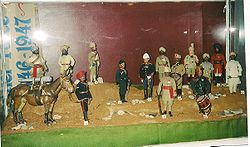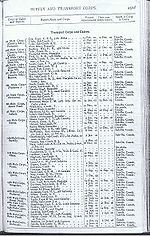Mule Corps: Difference between revisions
| Line 24: | Line 24: | ||
*[http://www.qmmuseum.lee.army.mil/WWII/mules_of_mars.htm The Mules of Mars] by 1st Lt. Don L. Thrapp, Q.M.C.''The Quartermaster Review'' May-June 1946. The Mars Task Force in Burma, 1944, USA Army | *[http://www.qmmuseum.lee.army.mil/WWII/mules_of_mars.htm The Mules of Mars] by 1st Lt. Don L. Thrapp, Q.M.C.''The Quartermaster Review'' May-June 1946. The Mars Task Force in Burma, 1944, USA Army | ||
*[http://www.lrgaf.org/military/mules.htm Mules for China] by Captain John A. Rand. Some were selected from other elements of the Mars Task Force | *[http://www.lrgaf.org/military/mules.htm Mules for China] by Captain John A. Rand. Some were selected from other elements of the Mars Task Force | ||
*[http://www.telegraph.co.uk/news/obituaries/military-obituaries/army-obituaries/5845146/Major-Victor-Warren.html Obituary of Major Victor Warren] 16 Jul 2009 ''The Telegraph''. In 1943 he commanded an Indian mule company which journeyed by train from the foot of the Khyber Pass to Karachi, sailed to Iraq and then made a 600-mile march through northern Syria to Tripoli in Lebanon; finally, it landed in Italy in 1944 to play a vital role in supplying forward infantry units with ammunition and blankets at the battle of Monte Cassino. | |||
*WW2Talk Forum [http://ww2talk.com/forums/topic/49469-mules thread] on mules, in Italy, where Sikh muleteers are mentioned, and Burma. (Images only available to [[Mailing lists#Military| logged in members ]] of WW2Talk Forum) | *WW2Talk Forum [http://ww2talk.com/forums/topic/49469-mules thread] on mules, in Italy, where Sikh muleteers are mentioned, and Burma. (Images only available to [[Mailing lists#Military| logged in members ]] of WW2Talk Forum) | ||
*Video: [http://www.iwm.org.uk/collections/item/object/1060030433 Evacuation of "special force" mules and men by waterborne craft made especially for the occasion] Burma WW2 contains some images of mules. Imperial War Museums | *Video: [http://www.iwm.org.uk/collections/item/object/1060030433 Evacuation of "special force" mules and men by waterborne craft made especially for the occasion] Burma WW2 contains some images of mules. Imperial War Museums | ||
*Details of a reprint edition by DP&G Publications of [http://www.military-naval-history.co.uk/pages/Artillery%20&%20Ordnance%20Collection.htm ''Handbook for the Q.F. 3.7-Inch Mark 1 Howitzer On Marks 1 and II & III Carriages, Land Service 1930''] (Scroll down). "With detailed instruction and photographs of Mule carrying & Packsaddlery... Covers and shows in photographic form the full packing and transport of this gun by Mule. With good quality close up photographs of the saddlery , loads on the Mules, method of harness & pulling of assembled load plus all the Gun parts & its assembly". | |||
*Details of a reprint edition by DP&G Publications of [http://www.military-naval-history.co.uk/pages/artillery.htm. ''The Military Mule in the British Army and Indian Army''] PartI I. Over two hundred years of invaluable service by Brian Nicholls. Part II. Indian army animal transport mule by Philip Malins Part III. Mountain artillery mule by Charles Macfetridge. Available at the Imperial War Museums. | |||
==Historic books online== | ==Historic books online== | ||
Revision as of 11:27, 15 October 2013
Mules formed part of the supply and transport section of armies and were particularly popular with expeditionary forces which had to travel over rougher terrain. A mule driver is called a muleteer.

Mule Corps of the Indian Army
Prior to 1884 no permanent transport department was established in the Indian Army and animals, carts and drivers were hired locally when required. Between 1884 and 1887 a separate transport corps existed. This became known as the Commissariat Transport Department and was under the control of the Military Department.
However by 1905 a further reorganisation had witnessed the emergence of a regular corps and cadres of mules, camels and cart transport. "This now consists of 21 mule corps, 9 silladar camel cadres and 2 pony cart train cadres. A mule corps is commanded by a British officer and is divided into two subdivisions, each in charge of a warrant officer. Those for cavalry brigades are divided into six draught and four pack troops , each under a daffadar and have a total strength of 552 all ranks, with 936 mules. Those for use wih other arms are divided into nine pack troops, each under a daffadar, and have a total strength of 388 of all ranks with 840 mules. Cadres of mule corps are commanded by a British Officer and maintain practically the full number of supervising and artificer establishments. They have, however, a much smaller number of mules." [1]
Fibiwiki article on Mountain Guns describes the artillery that could be carried by mules
The mule corps played an integral part in the various theatres of war during the First World War such as France, Gallipoli, Egypt and Basra.
Records

Details of where the individual sections of the Mule Corps were based each year are included in the annual Indian Army Lists under the section entitled "Supply and Transport Corps". (An example page from 1905 is shown).
External links
- British Army Transport Animals Excellent article by Clive Elliott containing lots of background information about the roles played by army mules with accompanying photos and diagrams.
- The History Of The Screw Gun By Colonel J.R.M. Hubel, CD AdeC BA M Ed limbergunners.ca. Includes a section on mules (scroll down)
- Photograph of Indian troops [7 Indian Mounted [Mountain?] Artillery Bde with mules, waiting to embark transport ship at Alexandria, Egypt. No 2278. 1916 from a collection of official photographs of the Dardanelles Expedition, 1915-1916. The Serving Soldier King’s College London
- About Mules c 1937 Extracts from the Manual of Horsemastership, Equitation, and Animal Transport 1937 - Published by Her Majesty's Stationery Office: London.
- Listen to the 1991 interview with Francis William Geoffrey Turner British officer served as brigade animal [mules] transport officer with 111 Indian Infantry Bde during First and Second Chindit Expeditions in Burma, 1943-1944. Imperial War Museums.
- The Stubborn but Courageous Mule in Burma WW2 www.chindit.net
- The Mules of Mars by 1st Lt. Don L. Thrapp, Q.M.C.The Quartermaster Review May-June 1946. The Mars Task Force in Burma, 1944, USA Army
- Mules for China by Captain John A. Rand. Some were selected from other elements of the Mars Task Force
- Obituary of Major Victor Warren 16 Jul 2009 The Telegraph. In 1943 he commanded an Indian mule company which journeyed by train from the foot of the Khyber Pass to Karachi, sailed to Iraq and then made a 600-mile march through northern Syria to Tripoli in Lebanon; finally, it landed in Italy in 1944 to play a vital role in supplying forward infantry units with ammunition and blankets at the battle of Monte Cassino.
- WW2Talk Forum thread on mules, in Italy, where Sikh muleteers are mentioned, and Burma. (Images only available to logged in members of WW2Talk Forum)
- Video: Evacuation of "special force" mules and men by waterborne craft made especially for the occasion Burma WW2 contains some images of mules. Imperial War Museums
- Details of a reprint edition by DP&G Publications of Handbook for the Q.F. 3.7-Inch Mark 1 Howitzer On Marks 1 and II & III Carriages, Land Service 1930 (Scroll down). "With detailed instruction and photographs of Mule carrying & Packsaddlery... Covers and shows in photographic form the full packing and transport of this gun by Mule. With good quality close up photographs of the saddlery , loads on the Mules, method of harness & pulling of assembled load plus all the Gun parts & its assembly".
- Details of a reprint edition by DP&G Publications of The Military Mule in the British Army and Indian Army PartI I. Over two hundred years of invaluable service by Brian Nicholls. Part II. Indian army animal transport mule by Philip Malins Part III. Mountain artillery mule by Charles Macfetridge. Available at the Imperial War Museums.
Historic books online
- On Two Fronts - Being the adventures of an Indian Mule Corps in France and Gallipoliby Major H M Alexander DCO 1917 archive.org
- "Mule Transport in Persia" by C E Biddulph page 407 The United Service Magazine Volume 8 New Series October 1893 to April 1894 Archive.org. Mules were purchased in Persia by the Indian Transport Department.
References